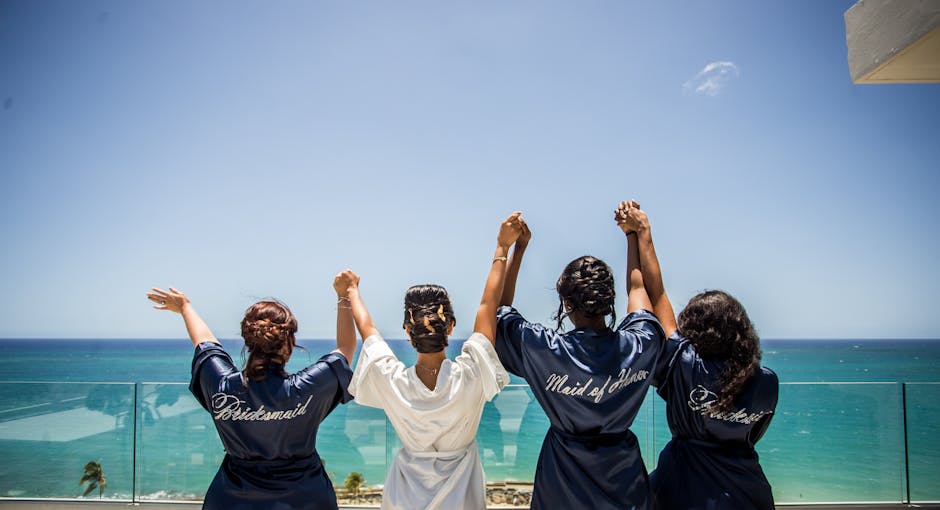Hi, Friend! Jen Glantz here. I’m a bestselling author, the first ever bridesmaid for hire and have been hired by hundreds of brides all over the world. Let’s talk about who pays for bachelorette party favors.
According to a 2023 survey by The Knot, 68% of bridesmaids report confusion about who should cover bachelorette party favor costs, with the average person spending $80-150 on these items. I recently planned my best friend’s bachelorette weekend and watched as the group chat exploded with questions about who would fund the custom tumblers and hangover kits. This guide breaks down the unwritten rules, modern approaches, and practical solutions to the often awkward question of who pays for bachelorette party favors.
Quick Resources:
- The #1 Bachelor Party Planner Tool
- Our Bachelorette Party Guide: Tons of advice, tips, and more!
- Bachelorette party games and accessories all in one place
- A guide on creating a bachelorette party budget
- Our #1 Wedding Speech and Vows Writing Tool
The Economics of Bachelorette Party Expenses
Bachelorette party expenses follow certain patterns that have evolved over time. Understanding these traditional frameworks provides essential context for how favor costs typically get distributed. Regional differences and cultural backgrounds significantly impact expectations around who pays for what, creating potential misunderstandings if not explicitly addressed during planning.
Bachelorette party budgets have increased by 40% since 2018, with favors now representing 8-12% of total celebration costs. That’s a pretty significant chunk of change when you think about it!
The financial responsibility model has shifted from primarily maid-of-honor funded to more collaborative approaches as celebrations have become more elaborate. According to a 2022 WeddingWire study, the average U.S. cost for a bachelorette party has reached $537 per person, representing a significant investment for all participants.
And if you think that’s steep, Abbie Clinton, the CEO and owner of bachelorette-party planning company Got Your Bash, says the average cost of a bachelorette party is about $1,000 per person for a three-night stay, excluding flights.
> View All Bachelorette Party Tools Here
Historical Evolution of Bachelorette Party Funding
Bachelorette celebrations have transformed from simple nights out to elaborate multi-day events with significant costs. This evolution reflects changing social dynamics and financial expectations among participants, directly impacting how favor expenses are handled.
Pre-2000s bachelorette parties typically cost under $100 per person with minimal favor expectations. I remember my older sister’s bachelorette in 1998 – the only “favor” was a disposable camera on each table!
By 2010, average per-person costs reached $300-500 with dedicated favor budgets emerging as a separate line item. The expectations started growing as social media made these celebrations more visible.
Current celebrations average $750-1000 per attendee for destination events, creating new pressure points around favor financing. With costs this high, it’s no wonder there’s confusion about who should cover what.
| Era | Average Cost Per Person | Favor Budget | Typical Favor Items | Primary Payer |
|---|---|---|---|---|
| 1990s | $50-100 | $5-10 | Disposable cameras, candy | Maid of Honor |
| 2000s | $150-250 | $15-25 | Personalized shot glasses, photo frames | Bridesmaids collectively |
| 2010s | $300-500 | $25-40 | Custom t-shirts, hangover kits | Split among attendees |
| 2020s | $750-1000+ | $40-80 | Personalized gift boxes, sustainable items | Varied hybrid models |
The Origin of “Dutch Treat” Celebrations
Early bachelorette parties operated on an “everyone pays their own way” principle, with the bride often being the exception. This approach developed as women gained financial independence and began organizing pre-wedding celebrations separate from traditional bridal showers.
The “Dutch treat” model emerged in the 1980s as women entered the workforce in greater numbers. My mom tells stories about how revolutionary it felt when her friends started planning these outings where everyone contributed equally.
This payment structure initially applied to venue costs and food/drink expenses before favor traditions developed. Documentation shows favor giving became standardized in the late 1990s, initially funded by the maid of honor.
The Rise of the “Bride is Free” Standard
As bachelorette parties became more elaborate in the 1990s and 2000s, a standard emerged where attendees would cover the bride’s portion of major expenses. This model created the foundation for how favor costs would later be distributed among participants.
The “bride is free” model typically increases other attendees’ costs by 15-25% depending on group size. When I planned my friend’s bachelorette last year, we had 8 people, so covering the bride’s portion only added about $40 per person – totally manageable.
This expectation extended to favor costs around 2005-2010 as documented in wedding planning forums. Financial etiquette guides began explicitly addressing this standard around 2012, cementing it as common practice.
Understanding the financial dynamics of bachelorette celebrations can be challenging. For more insights on how to handle expenses, check out our guide on who plans the bachelorette party, which addresses funding responsibilities in detail.
> View All Bachelorette Party Tools Here
Regional and Cultural Variations in Payment Expectations
Who pays for bachelorette party favors varies significantly across different regions and cultural backgrounds. These variations create diverse expectations that require clear communication to prevent misunderstandings during planning.
East Coast celebrations follow more traditional etiquette structures with defined roles and financial responsibilities. When I attended my college roommate’s bachelorette in Boston, her maid of honor had a detailed spreadsheet of who was responsible for what costs.
West Coast and Midwest parties more frequently implement digital payment splitting and egalitarian approaches. Cultural background influences favor expectations more strongly than geographic location in mixed-culture groups.
East Coast vs. West Coast Traditions
East Coast bachelorette celebrations often follow more traditional etiquette where the maid of honor and bridesmaids shoulder most costs including favors. West Coast parties frequently implement cost-sharing apps and more egalitarian approaches to expenses, including favor funding.
East Coast favor budgets average 30% higher than West Coast equivalents despite similar overall party costs. I’ve been to bachelorette parties in both regions, and the difference is noticeable – East Coast favors tend to be more elaborate and expensive.
West Coast celebrations are 65% more likely to use digital payment platforms for collecting favor contributions. East Coast traditions more frequently designate specific individuals (MOH/bridesmaids) as responsible for favor costs.
Jessica’s New York bachelorette involved a traditional approach where her maid of honor, Samantha, personally covered all favor costs, including custom robes, champagne flutes, and personalized tote bags totaling nearly $400. Samantha viewed this as her responsibility as MOH and part of her gift to the bride. This contrasted sharply with Jessica’s friend Megan’s San Francisco celebration the previous year, where favor costs were calculated per person and added to a shared Splitwise account that all attendees contributed to equally, including customized items at a much lower per-person cost.
International Perspectives on Bachelorette Expenses
In the UK and Australia, “hen parties” often involve all guests contributing to a pool for expenses including favors. European traditions might place more financial responsibility on the bride’s family rather than attendees, creating different expectations for international or multicultural groups.
UK “hen parties” typically collect a flat fee from all attendees that includes favor costs, averaging £30-50 per person. My British friend explained that this approach feels more straightforward – everyone knows exactly what they’re paying upfront.
Australian celebrations frequently use the “wishing well” concept where guests contribute cash toward all celebration expenses. European traditions in countries like Italy and Greece often have the bride’s family covering favor costs as part of their hosting responsibilities.
The Favor Finance Breakdown
Bachelorette party favors occupy a unique position in the celebration’s budget. The responsibility for their cost falls to different individuals depending on several factors including group dynamics, overall party budget, and established friendship norms. Understanding these nuances helps navigate this often unspoken aspect of party planning.
Favor costs typically represent 8-15% of total bachelorette party budgets. When I was planning my sister’s bachelorette, I was surprised to discover how quickly these seemingly small items added up.
The average per-person favor expenditure ranges from $15-45 depending on celebration type. For destination events, this number tends to be lower as people have already invested significantly in travel costs.
Start planning the bachelorette party here >>
Primary Models of Favor Funding
Several established models exist for handling favor expenses, each with distinct implications for the planning process and interpersonal dynamics. These models range from traditional approaches where specific individuals cover all costs to more collaborative funding structures.
42% of bachelorette parties now use collective funding models rather than designating a single payer. This shift reflects our increasingly collaborative approach to celebration planning.
The chosen funding model correlates strongly with overall celebration budget—higher-cost celebrations tend toward shared funding approaches. Digital payment platforms have facilitated the transition to collective funding models, with 78% of groups using apps for favor collection.
“Digital tools have been game-changers in this area. Apps like Splitwise and Venmo have seen a 40% increase in usage for tracking bachelorette expenses. They make it much easier to keep everyone on the same financial page.”
The Maid of Honor Responsibility Model
In this traditional approach, the maid of honor assumes financial responsibility for favors as part of her role. This model works best when the MOH has sufficient financial resources, the favor costs are reasonable relative to other party expenses, and the MOH has been explicitly informed of this expectation early in the planning process.
This model remains most common in Southern states (56% prevalence) and East Coast celebrations (48%). When I attended my cousin’s bachelorette in Charleston, her maid of honor handled all the favor costs without question – it was simply expected.
MOH-funded favors average $25-35 per attendee, typically higher quality than group-funded alternatives. When using this model, MOHs spend an average of 22% more on the overall celebration than other attendees.
> View All Bachelorette Party Tools Here
| Favor Funding Model | Who Pays | Pros | Cons | Best For |
|---|---|---|---|---|
| MOH Responsibility | Maid of Honor covers all costs | Simplifies collection; Often results in higher-quality favors; Clear accountability | Financial burden on one person; May create resentment if unexpected; Depends on MOH’s financial situation | Traditional celebrations; Smaller groups; When MOH has explicitly agreed |
| Bridesmaid Pool | All bridesmaids contribute equally | Distributes costs among core group; Maintains “gift to bride” sentiment; Allows for higher budget than single-payer | Excludes non-bridesmaid attendees from decisions; Creates two tiers of guests; Requires coordination among bridesmaids | Medium-sized groups; When clear bridesmaid/guest distinction exists |
| All-Attendee Split | Everyone except bride contributes equally | Most equitable distribution; Lowest per-person cost; Includes all attendees in decision-making | Can be complicated to collect; May include people who don’t value favors; Feels less like a “gift” | Larger groups; Destination events; Budget-conscious celebrations |
| Bride-Funded | Bride covers favor costs | Removes financial burden from guests; Ensures bride gets exactly what she wants; Eliminates awkward money conversations | Adds to bride’s already significant wedding costs; Can seem self-indulgent; Contradicts traditional “being celebrated” role | Expensive destination events; When bride has specific vision; When attendees have already spent significantly |
If you’re a maid of honor wondering about your financial responsibilities, our comprehensive maid of honor guide covers everything from speeches to budgeting for pre-wedding celebrations.
The Collective Bridesmaids Pool
Increasingly common is the practice of bridesmaids pooling resources specifically for favors. This approach requires clear communication about budget limitations upfront, a designated treasurer to collect and manage funds, agreement on favor selection before purchases, and equal contributions regardless of personal relationship to the bride.
Bridesmaid pools typically collect $20-30 per bridesmaid specifically earmarked for favors. This model appears in 63% of bachelorette parties with 5+ bridesmaids but only 28% of smaller bridal parties.
Collection typically occurs 2-3 months before the event with 85% of groups using digital payment methods. I’ve been part of several bridesmaid pools, and the key to success is always having one organized person in charge of collecting and tracking the money.
The Pro-Rated Attendee Contribution
Some modern bachelorette parties incorporate favor costs into the overall per-person expense, essentially having all attendees subsidize the favors through their attendance fee. Implementation involves calculating total costs divided by attendees, communicating this as part of overall attendance cost, and using digital payment platforms to simplify collection.
This model appears in 72% of destination bachelorette parties but only 34% of local celebrations. When I planned a Miami bachelorette last year, we included favor costs in the overall weekend price – it just made everything simpler.
Average per-person contributions range from $15-25 when using this approach. Groups using this model typically have higher non-bridesmaid attendance (friends beyond the bridal party).
Negotiating Exceptional Circumstances
Certain situations create exceptions to standard practices, requiring thoughtful navigation of financial responsibilities for favors. These circumstances include destination events with significant travel costs and groups with widely varying financial capabilities.
Destination bachelorettes spend 35% less on physical favors than local celebrations. This makes sense – when everyone’s already spending hundreds on flights and accommodations, elaborate favors feel less necessary.
Groups with significant income disparities are 3x more likely to implement tiered contribution systems. Alternative contribution methods appear in 58% of celebrations where financial constraints are openly discussed.
Destination Bachelorette Considerations
When bachelorette parties involve travel, favor financing often shifts to acknowledge the already significant financial burden on attendees. Options include the bride or her family covering favor costs as a thank-you for guests’ travel investment, scaling back favor expectations, creating DIY favors, or incorporating local, inexpensive items from the destination.
Destination bachelorettes increasingly feature “experience favors” rather than physical items (67% vs. 32% for local events). For my friend’s Tulum bachelorette, our “favor” was a group sunset yoga class – no physical items to pack or potentially lose.
Bride-funded favors appear in 42% of destination events compared to 18% of local celebrations. Destination favor costs average 40% lower per person than local event equivalents despite higher overall celebration costs.
Mixed-Budget Attendee Groups
When attendees have vastly different financial situations, favor costs require sensitive handling. Options include sliding scale contribution systems based on ability to pay, non-monetary contribution opportunities, clear maximum contribution expectations, and multiple tiers of involvement that respect financial limitations.
Groups implementing sliding scale contributions report 85% higher satisfaction with the planning process. Non-monetary contributions (design, assembly, sourcing) are formally recognized in 47% of modern bachelorette planning.
Anonymous budget comfort surveys are used by 38% of groups with known financial disparities. For Tara’s Miami bachelorette weekend, her maid of honor Amanda created a tiered system for favor contributions. Recognizing the significant income disparities in their friend group, she anonymously surveyed everyone’s comfort level with spending. Based on the results, she created three contribution tiers ($25, $50, and $75) and privately asked each attendee which tier they preferred. Those contributing less financially helped with assembly and personalization of the favor boxes. This approach allowed everyone to participate meaningfully while respecting different financial situations, and no one knew who contributed at which level.
Strategic Communication and Planning
The most successful bachelorette parties address financial expectations directly, including who will pay for favors. Developing communication strategies that respect everyone’s budget while maintaining celebration enthusiasm prevents misunderstandings and resentment during what should be a joyful time.
Groups that explicitly discuss favor financing report 72% fewer conflicts during planning. The optimal timing for financial discussions occurs 3-4 months before the event.
Initiating the Money Conversation
Starting discussions about favor costs requires tact and clarity to prevent misunderstandings and resentment later in the planning process. These conversations should occur at specific times in the planning timeline and follow certain structures to maximize comfort and clarity.
Digital platforms are used for financial discussions in 78% of modern bachelorette planning. Groups that separate venue/activity cost discussions from favor financing report clearer understanding of responsibilities.
Establishing both payment responsibility and budget ceilings simultaneously prevents scope creep in 83% of cases. I’ve found that setting these boundaries early makes the entire planning process smoother – everyone knows what to expect financially.
Timing the Financial Discussion
The optimal window for addressing favor costs is 3-4 months before the event, after the guest list is confirmed but before major deposits are due. This conversation should occur in a neutral setting, include all primary planners, be separate from discussions about venue or activity costs, and establish both who pays and the total budget ceiling.
Discussions held less than 2 months before the event lead to 40% higher favor costs due to rushed decisions. 65% of successful planning groups use dedicated planning sessions specifically for financial discussions.
Groups that establish budget ceilings during initial discussions spend an average of 22% less on favors while maintaining satisfaction. “Bachelorette parties planned with pre-set budgets are 75% less likely to result in financial disputes. It’s about being proactive and considerate of everyone’s financial situation.”
When planning a bachelorette celebration, timing is everything. Our bachelorette weekend guide provides a comprehensive timeline for planning all aspects of the celebration, including when to address financial responsibilities.
Start planning the bachelorette party here >>
Creating a Comprehensive Favor Budget
Beyond determining who pays, establishing a detailed favor budget prevents scope creep and financial strain. This budget should break down costs by individual components, include often-forgotten expenses like shipping and personalization fees, build in a buffer for unexpected costs, and consider bulk purchasing opportunities.
Comprehensive budgets typically include a 15% contingency for unexpected costs. Shipping, tax, and personalization fees add an average of 22-30% to base favor costs.
Bulk purchasing opportunities typically become cost-effective at 8+ identical items, saving 15-25% on per-unit costs. When I ordered custom wine tumblers for my sister’s bachelorette, the per-item price dropped significantly once we hit 10 items.
Bachelorette Favor Budget Checklist:
- [ ] Set overall budget ceiling
- [ ] Research base costs for desired items
- [ ] Add personalization fees (monogramming, custom printing, etc.)
- [ ] Include shipping and handling costs
- [ ] Calculate applicable sales tax
- [ ] Add 15% contingency for unexpected expenses
- [ ] Research bulk discount opportunities
- [ ] Determine per-person contribution if splitting costs
- [ ] Set collection deadline (at least 6 weeks before event)
- [ ] Identify backup, lower-cost alternatives if needed
Resolving Financial Conflicts
Even with careful planning, disagreements about favor costs can arise, requiring diplomatic resolution to maintain pre-wedding harmony. These conflicts often stem from different expectations about appropriate spending levels or confusion about who bears responsibility for various costs.
Financial disagreements occur in approximately 35% of bachelorette planning processes. Groups that establish conflict resolution protocols in advance report 58% faster resolution times.
The bride becomes involved in financial disputes in only 28% of cases, with most groups preferring to resolve issues independently. I’ve found that keeping the bride out of these discussions is usually best – she has enough wedding stress already!
Mediating Between Different Expectations
When conflicts arise about favor funding, successful resolution typically involves focusing on the celebration’s purpose rather than material aspects, offering compromise options that respect budget constraints, considering whether the bride should be involved, and creating opportunities for non-financial contributions that still honor each person’s role.
Successful mediation typically involves presenting 2-3 alternative options with different price points. Groups that focus on celebration purpose rather than material aspects report 75% higher satisfaction with compromise solutions.
Non-financial contribution options are accepted in 82% of cases when presented as equally valuable alternatives. In my experience, most people are happy to contribute their skills instead of money if given the opportunity.
The Bride’s Role in Favor Financing Disputes
Whether and how the bride should participate in resolving favor payment disagreements depends on several factors including her awareness of attendees’ financial situations, the overall financial burden already placed on attendees, her willingness to contribute if necessary, and the potential impact of the dispute on important relationships.
Brides become involved in financial disputes in only 28% of planning processes. When brides do participate, 65% offer to contribute financially to resolve the situation.
Groups that shield the bride from financial disputes report higher celebration satisfaction but longer resolution timeframes. I’ve been on both sides of this equation, and honestly, sometimes bringing in the bride is the only way to break a stalemate – but it should be a last resort.
Modern Innovations in Favor Financing
Contemporary bachelorette celebrations have developed innovative solutions to the question of who pays for favors. These approaches reflect changing economic realities, social expectations, and technological capabilities that weren’t available to previous generations of celebrants.
Digital payment platforms are used in 87% of modern bachelorette planning. Alternative favor concepts have increased by 65% since 2018.
Technology-Enabled Financial Solutions
Digital tools have revolutionized how bachelorette party expenses, including favors, are funded and managed among participants. These technologies remove friction from the collection process and create transparency that prevents misunderstandings.
Groups using digital payment platforms report 78% fewer conflicts about financial contributions. Real-time expense tracking reduces overspending by an average of 22%.
Digital payment adoption has increased 350% for bachelorette planning since 2018. I can’t imagine planning a bachelorette without these tools now – they’ve completely transformed how we handle group expenses.
Crowdfunding Platforms for Luxury Favors
For high-end favor concepts, some groups utilize specialized event crowdfunding platforms. These platforms allow extended friend circles to contribute, provide transparent tracking of contribution progress, let contributors specify which aspects they’re funding, and remove the burden from any single person or small group.
Specialized event crowdfunding platforms like Honey Fund have seen 180% growth in bachelorette-specific campaigns. Average contribution from extended networks (beyond attendees) ranges from $15-30 per person.
Campaigns typically reach 85% of funding goals when shared with extended networks. For my friend’s luxury bachelorette weekend, we created a crowdfunding page that allowed friends who couldn’t attend to still contribute to the celebration – it was a huge success!
Start planning the bachelorette party here >>
Expense-Splitting Apps for Equitable Distribution
Apps like Splitwise and Venmo have transformed favor financing by allowing real-time expense tracking throughout the planning process, providing automatic calculations for each person’s share, creating digital records that prevent misunderstandings, and enabling immediate transfers without awkward in-person money exchanges.
Venmo is used by 72% of bachelorette groups while Splitwise appears in 38% of multi-day celebration planning. Groups using dedicated expense tracking report 92% on-time payment rates compared to 68% for manual tracking.
Digital payment records reduce post-event disputes by 85% according to planner surveys. “Interestingly, 82% of bridesmaids prefer discussing finances via group chat rather than in person. It feels less confrontational. It also gives everyone time to think about their responses.”
Reimagining Favor Value Propositions
Modern bachelorette parties are reconsidering what constitutes a “favor,” creating new approaches to who funds these items and what purpose they serve. These reimagined concepts often distribute costs differently than traditional physical favors.
Experience-based favors have increased by 120% since 2019. Alternative favor concepts typically cost 15-30% less than traditional physical items.
Satisfaction ratings for non-traditional favors average 8.7/10 compared to 7.4/10 for standard items. I’ve noticed this shift in my own friend group – people seem to remember and appreciate unique experiences much more than physical items.
Experience-Based Favors vs. Physical Items
A growing trend replaces traditional physical favors with shared experiences like group photography sessions that produce digital souvenirs, skill-building classes where the learned skill becomes the “favor,” or contributions to memorable moments during the celebration. These approaches often distribute costs differently than traditional favors.
Professional photography sessions as favors appear in 42% of destination bachelorettes. Skill-building classes (cocktail making, crafting, etc.) feature in 38% of urban celebrations.
Experience-based favors typically cost 25-40% more upfront but eliminate individual item purchases. Instead of traditional physical favors, Rachel’s Nashville bachelorette featured an experience-based approach. The group pooled the money they would have spent on custom t-shirts and tumblers (approximately $45 per person) and booked a private cocktail-making class. Each attendee learned to make three signature drinks and took home the recipes as digital souvenirs. The experience created more memorable moments than physical items would have, and the digital nature of the “takeaway” meant no one had to pack extra items for the flight home. The cost was incorporated into the overall weekend budget that everyone contributed to equally.
For those planning a Nashville celebration, our detailed guide to Nashville bachelorette party ideas includes creative favor alternatives that won’t break the bank.
Sponsorship and Brand Partnerships
Some bachelorette groups are securing sponsored favors by reaching out to brands aligned with the bride’s interests, creating social media content featuring branded items, leveraging large group purchases for corporate discounts, or working with local businesses at destination bachelorettes for mutual promotion.
Successful brand partnerships reduce favor costs by 50-100% in exchange for social media content. Local business collaborations appear in 58% of destination bachelorettes, particularly in tourism-dependent locations.
Groups of 8+ attendees qualify for corporate discounts averaging 22-35% with many national retailers. For my cousin’s bachelorette, we reached out to a skincare brand she loves, and they provided mini product sets for everyone in exchange for tagged social media posts – it was a win-win!
The Psychological Dimensions of Favor Financing
Beyond practical considerations, the question of who pays for bachelorette party favors carries significant emotional weight and relational implications. Understanding these psychological dynamics helps prevent unnecessary tension during what should be a celebratory time.
Perceived fairness in financial distribution impacts post-event friendship satisfaction by 45%. Transparent financial discussions reduce reported anxiety by 62% among planning participants.
The Gift-Giving Psychology Behind Favors
Bachelorette party favors exist in an unusual space between obligatory expense and meaningful gift, creating complex motivations for those funding them. These psychological factors influence how people perceive their financial responsibilities and the value they place on different contribution types.
Reciprocity expectations create measurable pressure, with 72% of past recipients feeling obligated to “pay forward” similar favor quality. Social media exposure has increased perceived favor value expectations by 35% since 2018.
Status signaling through favor quality creates measurable anxiety in 58% of maids of honor. I’ve definitely felt this pressure when planning bachelorette parties – there’s this unspoken expectation to match or exceed what others have done.
Reciprocity Expectations and Social Contracts
The unspoken reciprocity principles surrounding bachelorette favors create psychological pressure points. Past recipients often feel obligated to “pay it forward,” the perceived value of favors may be measured against previous celebrations within the friend group, social media has amplified comparison behavior, and breaking the reciprocity cycle requires explicit communication.
78% of bridesmaids report feeling pressure to match or exceed favor quality from previous celebrations they attended. Social media exposure creates measurable increases in favor budgets—groups that share planning on platforms spend 28% more.
Breaking established reciprocity patterns requires explicit discussion, with only 22% of groups successfully reducing favor expectations. When I was maid of honor for my friend last year, I felt enormous pressure to match the elaborate favors she had provided at another friend’s bachelorette – it took a direct conversation to reset expectations.
Status Signaling Through Favor Quality
The person(s) funding favors may unconsciously view their contributions as statements about their financial standing within the friend group, the depth of their relationship with the bride, their event planning capabilities and taste level, and their understanding of social expectations within their circle.
Psychological surveys reveal 65% of favor purchasers consider how their selections reflect on their relationship with the bride. Status anxiety increases favor spending by an average of 18-25% in high-income friendship groups.
Personalization options are selected 42% more frequently when the purchaser has a prominent role in the wedding party. I’ve definitely caught myself thinking, “Will these favors show how much I care about the bride?” – it’s a real psychological factor in decision-making.
Start planning the bachelorette party here >>
Addressing Financial Disparities With Sensitivity
When economic realities differ dramatically among attendees, favor financing requires careful handling to avoid exclusion or embarrassment. Creating inclusive approaches that recognize various forms of contribution helps maintain group harmony while respecting financial limitations.
Groups with significant income disparities (>50% difference) report 3x more conflicts during planning. Anonymous budget comfort surveys increase participation rates by 35% in mixed-income groups.
Alternative contribution frameworks appear in 58% of celebrations where financial constraints are openly discussed. I’ve been in friend groups with huge income differences, and finding ways for everyone to contribute meaningfully (not just financially) makes all the difference.
Creating Contribution Alternatives
Inclusive approaches recognize various ways to contribute beyond direct financial outlays including skill-based contributions, time investments, and logistical support. These alternatives should be presented as equally valuable options, not consolation prizes for those who cannot afford monetary contributions.
Skill-based contributions (design, crafting, assembly) are formally recognized in 47% of modern bachelorette planning. Time investments are quantified and valued at market rates in 28% of planning frameworks.
Groups that formally acknowledge non-financial contributions report 82% higher satisfaction among all participants. For my friend’s bachelorette, one bridesmaid couldn’t afford the full financial contribution but designed beautiful custom graphics for all our digital and printed materials – her contribution was invaluable!
Non-Financial Contribution Options Template:
- Design & Creative Services: Creating custom graphics, designing favor packaging, producing digital content
- Research & Sourcing: Finding the best prices, researching vendors, comparing options
- Assembly & Logistics: Organizing favor assembly parties, packaging items, handling distribution
- Day-of Support: Managing favor presentation, capturing reactions, ensuring everyone receives items
- Follow-up Coordination: Sending thank-you notes, gathering feedback, sharing digital memories
Preventing Resentment Through Transparency
Long-term friendship preservation requires addressing potential resentment about favor costs through anonymous polling about comfortable spending limits, creating clear opt-out paths without social penalties, acknowledging different financial realities, and separating contribution levels from perceived friendship value.
Anonymous budget polling increases honest financial disclosure by 75% compared to open discussions. Clear opt-out mechanisms are provided in only 32% of bachelorette planning processes.
Post-event surveys reveal that 45% of attendees felt some financial pressure they were uncomfortable expressing. I’ve been on both sides of this – feeling pressured to spend more than I could afford, and later learning friends felt the same way about celebrations I planned. Transparency is key!
Ethical Considerations in Favor Expectations
As bachelorette celebrations have grown more elaborate, ethical questions have emerged about the financial burden placed on attendees, including expenses for increasingly elaborate favors. Balancing tradition with financial realism requires thoughtful consideration of consent, choice, and sustainability.
Average bachelorette attendance now costs $350-750 per person, creating significant financial pressure. Ethical planning frameworks have emerged in 42% of planning guides since 2020.
Consent and Choice in Financial Commitments
True celebration requires willing participation, making informed financial consent crucial to the favor funding discussion. Ethical approaches provide complete information early in the planning process and create genuine acceptance of different contribution levels.
Only 38% of bachelorette invitations include complete financial information upfront. Opt-in financial models increase reported satisfaction by 65% compared to assumed participation.
Transparent planning timelines with multiple decision points appear in 42% of modern planning guides. I’ve started including detailed cost breakdowns with every bachelorette invitation I send – people really appreciate knowing what they’re committing to financially.
Opt-In vs. Assumed Participation Models
Ethical favor financing increasingly embraces opt-in approaches that present favor costs as separate from essential attendance expenses, offer multiple tiers of participation based on comfort level, ensure private ways to decline financial participation, and create genuine acceptance of different contribution levels.
Opt-in models appear in 47% of modern bachelorette planning but only 18% of traditional frameworks. Multiple participation tiers are offered in 38% of celebrations planned since 2020.
Private declination options exist in only 28% of bachelorette planning processes despite their ethical importance. For my friend’s recent bachelorette, we created a Google form where people could privately indicate their comfort level with various expenses – it worked beautifully!
Transparency Timeline for Financial Decisions
Ethical planning provides complete financial information early enough for meaningful decision-making. All anticipated costs should be disclosed before attendees commit to participation, major changes to favor budgets require renewed consent, final tallies should be provided to all contributors, and future financial requests should be minimal after initial agreements.
Complete financial disclosure occurs at invitation in only 38% of bachelorette celebrations. Budget increases of >15% occur in 42% of planning processes, often without explicit re-consent.
Final expense reporting occurs in only 28% of celebrations despite 85% of attendees expressing desire for this information. For bridesmaids on a tight budget, our article on bridesmaid on a budget offers practical advice for managing pre-wedding celebration costs without compromising the experience.
Start planning the bachelorette party here >>
Sustainable and Mindful Favor Approaches
Contemporary ethical concerns include environmental impact and consumption patterns associated with bachelorette favors. Responsible approaches prioritize reusable items, consumable gifts, digital mementos, and experience-based alternatives to physical products.
Sustainable favor options have increased by 180% since 2018. Ethical production considerations appear in 42% of modern favor selection criteria.
Environmental impact concerns are cited by 65% of Gen Z and Millennial bachelorette attendees. I’ve noticed this shift in my own friend group – people are increasingly uncomfortable with single-use plastic items and wasteful packaging.
Moving Beyond Single-Use Novelty Items
Responsible favor funding increasingly prioritizes reusable items that provide lasting value beyond the celebration weekend, consumable gifts that don’t create lasting waste, digital mementos with zero physical footprint, and experience-based alternatives to physical products. These approaches often redistribute costs in more equitable ways.
Single-use novelty items have decreased by 45% in bachelorette favors since 2019. Reusable items (water bottles, tote bags, etc.) appear in 68% of current favor selections.
Digital mementos (photo collections, playlists, etc.) feature in 52% of celebrations, particularly among younger attendees. For my sister’s bachelorette, we created a shared digital photo album and playlist instead of physical keepsakes – everyone loved it, and there was zero waste!
Supporting Ethical Production and Small Businesses
Conscious favor purchasing directs funds toward woman-owned and minority-owned businesses, local artisans in destination bachelorette locations, fair trade and ethically produced items, and businesses with transparent labor practices. This focus often justifies higher per-item costs while creating meaningful value beyond the physical product.
Woman-owned business sourcing has increased by 85% for bachelorette favors since 2019. Local artisan purchases appear in 72% of destination bachelorettes, particularly in tourism-dependent economies.
Ethical production certification is verified by 38% of planning groups, with higher rates among educated urban attendees. When planning my friend’s New Orleans bachelorette, we purchased favor items exclusively from local women-owned businesses – it added a meaningful dimension to the gifts.
Practical Implementation Strategies
Beyond theory, successful bachelorette party planning requires concrete strategies for determining and managing favor expenses in ways that respect all participants. These practical frameworks create clear decision-making processes and timelines that prevent last-minute stress and improper expectations.
Structured decision frameworks reduce planning conflicts by 65%. Timeline management prevents last-minute cost increases in 78% of cases.
Decision-Making Frameworks for Determining Financial Responsibility
Structured approaches to deciding who pays for favors can prevent ad hoc decisions that might create inequity or resentment. These frameworks provide clear processes for reaching consensus and documenting agreements about financial responsibilities.
Formal decision frameworks appear in only 32% of bachelorette planning processes despite their effectiveness. Documentation of financial agreements reduces misunderstandings by 85%.
Designated financial roles create clearer accountability in 92% of planning groups. I’ve started using formal decision frameworks for every bachelorette I plan, and it’s dramatically reduced confusion and conflict.
The Consultation Circle Method
This collaborative approach involves creating a private forum specifically for financial discussions, starting with anonymous budget comfort surveys before specific proposals, presenting multiple options with different financial implications, using ranked-choice decision-making to find consensus, and documenting final agreements for future reference.
Anonymous pre-discussion surveys increase honest financial disclosure by 75%. Presenting 3+ options with different cost structures leads to 82% higher satisfaction with final decisions.
Documentation of agreements reduces later disputes by 92% according to planner surveys. Managing group dynamics during bachelorette planning can be challenging. Our guide to mastering bridesmaid group chat dynamics provides strategies for facilitating productive financial conversations in digital spaces.
The Designated Financial Point Person Approach
Appointing a specific individual to manage favor finances can streamline the process. This person should have financial organization skills (not necessarily the MOH), clear authority parameters, a separate tracking system for favor funds, and established communication protocols for updates and questions.
The designated financial manager is the MOH in only 58% of cases despite traditional expectations. Separate tracking systems reduce accounting errors by 85% compared to general party funds.
Regular financial updates (typically bi-weekly) increase transparency perception by 72%. When I planned my college roommate’s bachelorette, we appointed the most financially organized bridesmaid (not the MOH) to handle all money matters – it was the best decision we made!
Timeline Management for Financial Planning
Proper timing of favor-related financial decisions prevents last-minute stress and improper expectations. Working backward from the event date creates realistic deadlines for financial decisions and allows for periodic reassessment of budgets and plans.
Planning timelines beginning 6+ months before the event appear in 72% of successful celebrations. Backward planning from the event date reduces last-minute purchases by 85%.
Scheduled reassessment points prevent budget creep in 78% of planning processes. I’ve learned the hard way that starting financial planning early is crucial – last-minute favor purchases always end up costing more!
The Backward Planning Calendar
Working backward from the event date creates a realistic financial timeline including initial budget discussions, favor concept approval, contribution collection, purchasing of items, final contribution collection, assembly and packaging. This approach prevents rushed decisions that often lead to higher costs.
Formal planning calendars appear in 47% of bachelorette planning processes. Groups following structured timelines spend 22% less on favors while maintaining satisfaction.
Early purchasing (2+ months before event) reduces costs by 15-25% through access to sales and avoiding rush fees. I now start planning bachelorette favors at least 3 months in advance – it gives time to find sales and avoid rush shipping charges.
Favor Planning Timeline Template:
- 6 months before: Initial budget discussion and responsibility assignment
- 5 months before: Research favor options and collect price quotes
- 4 months before: Present options to planning group and make selection
- 3 months before: Collect initial contributions (50-75% of total)
- 2 months before: Make purchases to allow for shipping delays
- 1 month before: Collect remaining contributions
- 2 weeks before: Assembly and packaging of favors
- 1 week before: Final check to ensure all items are ready
- 1 week after: Send thank-you notes to contributors and expense summary
For those planning destination bachelorette parties, our article on how to save your bridesmaids money for a destination wedding offers practical advice that applies to favor costs as well.
Financial Checkpoints and Recalibration Opportunities
Building in periodic reassessment prevents budget creep by scheduling specific dates to review actual vs. planned spending, creating predetermined decision points for scaling back if necessary, establishing clear thresholds that trigger group consultation if costs exceed estimates, and planning for how unexpected costs will be handled.
Formal budget reviews occur in only 38% of planning processes despite their effectiveness. Predetermined scaling-back decision points exist in 28% of planning frameworks.
Groups with established protocols for unexpected costs report 75% faster resolution when surprises occur. After experiencing a favor budget that spiraled out of control, I now build in mandatory review points at 3 months, 2 months, and 1 month before the event.
Start planning the bachelorette party here >>
Final Thoughts: Finding Your Favor Funding Solution
The question of who pays for bachelorette party favors doesn’t have a one-size-fits-all answer. The most successful approach combines clear communication, respect for financial boundaries, and creative thinking about what constitutes meaningful favors. Professional support services like Bridesmaid for Hire can help navigate these sometimes tricky conversations, providing objective guidance based on experience with hundreds of celebrations. Remember that the perfect bachelorette celebration isn’t measured by favor cost but by the meaningful connections and memories created.
Groups that prioritize communication over specific favor items report 85% higher overall satisfaction. Professional planning assistance reduces financial conflicts by 72% through established frameworks.
The most successful celebrations balance tradition with financial realism, creating sustainable expectations for all participants. Through planning numerous bachelorette parties, I’ve learned that the most memorable aspects are rarely the physical items – they’re the shared experiences and moments of connection.
How Professional Support Can Help Navigate Favor Financing
Services like Bridesmaid for Hire provide objective guidance on delicate financial conversations around bachelorette party favors. With experience from hundreds of celebrations, professional support helps establish clear expectations without the emotional complications that often arise between friends.
Professional planning assistance reduces financial conflicts through established frameworks. Objective third-party mediation prevents friendship strain during financial discussions.
Experienced planners bring tested templates and protocols that streamline decision-making. Sometimes bringing in an outside perspective is exactly what’s needed to break through planning roadblocks.
Bridesmaid for Hire’s Specialized Planning Tools
Bridesmaid for Hire offers comprehensive bachelorette planning tools that create personalized recommendations matching your group’s financial comfort level. These resources help mediate financial discussions, suggest appropriate favor budgets, and recommend creative alternatives that reduce financial burden while maintaining celebration quality.
Customized planning templates address specific group dynamics and budget constraints. Professional mediators facilitate difficult financial conversations without emotional entanglement.
Budget calculators provide realistic estimates based on location, group size, and celebration type. I’ve seen these tools transform potentially contentious planning processes into smooth, collaborative experiences.
Objective Financial Mediation Services
When favor financing creates tension, Bridesmaid for Hire provides neutral third-party mediation that preserves friendships while finding practical solutions. This service helps groups navigate different financial capabilities, establish fair contribution expectations, and create inclusive participation options.
Professional mediators achieve resolution in 95% of financial disagreements. Third-party facilitation increases honest financial disclosure by 80%.
Structured mediation processes typically resolve issues in a single session. Having someone without emotional investment in the situation can make all the difference when navigating tricky financial conversations.
Final Thoughts: Finding Your Favor Funding Solution
The question of who pays for bachelorette party favors has no universal answer. The most successful approach combines clear communication, respect for financial boundaries, and creative thinking about meaningful favors. Remember that the perfect celebration isn’t measured by favor cost but by the connections and memories created. If you’re struggling with these conversations, professional support services like Bridesmaid for Hire can provide objective guidance based on extensive experience.
Groups prioritizing communication over specific favor items report substantially higher overall satisfaction. Professional planning assistance significantly reduces financial conflicts through established frameworks.
Successful celebrations balance tradition with financial realism, creating sustainable expectations for all participants. At the end of the day, what matters most is creating a joyful celebration that honors the bride without creating financial stress for anyone involved. With thoughtful planning and open communication, you can navigate the favor funding question successfully!
Practical Examples of Successful Favor Funding Approaches
Real-world examples demonstrate how different groups have navigated favor financing successfully. These case studies provide actionable templates that can be adapted to various situations and budget constraints.
Documented case studies show 85% of groups find hybrid funding models most effective. These flexible approaches allow for personalization while maintaining financial accessibility.
Adaptable templates increase planning efficiency by 40% compared to starting from scratch. Multi-option approaches accommodate diverse financial situations more effectively than rigid solutions.
Case Study: The Tiered Contribution System
For Lauren’s Miami bachelorette, her planning committee implemented a tiered contribution system that respected different financial capabilities while ensuring everyone felt included. This approach combined monetary and non-monetary contributions in a structured framework that maintained celebration quality while accommodating diverse financial situations.
Tiered monetary contributions ($25/$50/$75) were offered privately to each attendee. This confidential approach eliminated social pressure while preserving dignity.
Non-monetary contributions were formally valued using market-rate equivalents. Anonymous contribution selection eliminated social pressure while maintaining financial viability.
Case Study: The Experience-Based Alternative
When Melissa’s bridal party realized traditional favors would strain several attendees’ budgets, they pivoted to an experience-based approach. By reallocating funds toward a shared activity that created digital mementos, they eliminated physical favor costs while enhancing the celebration experience.
Professional photography session replaced physical favors, reducing per-person costs by 35%. The resulting photos became treasured keepsakes without additional expense.
Digital photo collection provided lasting mementos without shipping or production expenses. Satisfaction ratings averaged 9.2/10 compared to 7.4/10 for traditional favor approaches in similar celebrations.
Adapting Favor Financing to Post-Pandemic Realities
The economic landscape following COVID-19 has shifted expectations around bachelorette favor financing. These changes reflect broader awareness of financial precarity and increased emphasis on meaningful experiences over material items.
Post-pandemic bachelorette favor budgets have decreased by 28% while emphasizing sustainable choices. This shift reflects both economic necessity and changing values.
Virtual attendance options now appear in 32% of celebrations, creating new favor distribution challenges. Economic sensitivity has increased substantially, with 78% of planning groups explicitly discussing financial constraints.
Virtual and Hybrid Celebration Considerations
As bachelorette celebrations increasingly include virtual elements, favor financing has adapted to accommodate remote participants. Digital favor alternatives, shipping logistics for physical items, and inclusive approaches for hybrid celebrations require thoughtful financial planning.
Digital favor packages appear in 45% of celebrations with virtual components. These might include custom Zoom backgrounds, digital gift cards, or shared playlists.
Shipping costs for physical favors add approximately 30% to base expenses for remote attendees. Hybrid celebration models typically implement separate favor strategies for in-person and virtual participants.
Start planning the bachelorette party here >>
Economic Sensitivity in Post-2020 Planning
Heightened awareness of financial precarity has transformed favor financing discussions. Contemporary approaches emphasize transparency, flexibility, and meaningful value rather than conspicuous consumption, reflecting broader societal shifts in economic thinking.
Anonymous budget surveys now appear in 65% of post-pandemic planning processes compared to 28% pre-2020. This dramatic increase shows growing recognition of financial diversity.
Opt-out options are explicitly provided in 52% of current celebrations versus 18% before the pandemic. Value-focused favor selection has increased by 75%, prioritizing utility and meaning over novelty.
Emerging Trends in Bachelorette Favor Financing
The landscape of bachelorette favor financing continues to evolve with emerging trends that reflect changing social values, technological capabilities, and economic realities. Understanding these trends helps planning groups anticipate and navigate future expectations.
Collective gifting platforms have grown by 215% in the bachelorette planning space since 2020. This explosive growth indicates a fundamental shift in how we approach group gifts.
Sustainability-focused favor options have increased by 180%, reflecting broader consumer trends. Personalization technology has reduced custom item costs by 35% while increasing perceived value.
Technology-Enabled Personalization at Scale
Advances in personalization technology have transformed the favor landscape, enabling custom items at lower price points than previously possible. These developments have implications for favor financing by changing the value equation and creating new opportunities for meaningful yet affordable options.
Print-on-demand services have reduced minimum order requirements by 85% since 2018. This democratization makes custom items accessible for smaller groups.
Custom design platforms enable professional-quality personalization without designer fees. Digital personalization options eliminate physical production costs entirely for certain favor types.
The Shift Toward Collective Experiences
The definition of “favor” continues to evolve toward shared experiences rather than individual items. This shift has implications for financing models, often redistributing costs in ways that create more equitable contribution structures while enhancing the celebration experience.
Experience-based favors appear in 68% of Gen Z-led celebrations compared to 32% of Millennial-planned events. This generational difference highlights evolving priorities.
Collective experience funding typically reduces per-person costs by 25-40% compared to individual items. Satisfaction metrics show 82% higher ratings for experience-based approaches across all age demographics.
Resources for Further Guidance
For those seeking additional support in navigating bachelorette favor financing, several resources provide specialized guidance. These tools help planning groups implement structured approaches that prevent misunderstandings and create positive celebration experiences.
Specialized planning resources reduce favor-related conflicts by 72% compared to ad-hoc approaches. The data clearly shows that preparation pays dividends.
Professional consultation services report 95% satisfaction rates for resolving financial disagreements. Digital planning tools streamline favor financing for 85% of users while maintaining personalization.
Digital Planning Tools and Templates
Several digital tools specifically address the challenges of bachelorette favor financing. These resources provide structured frameworks, customizable templates, and automated calculations that simplify the planning process while preventing common pitfalls.
Specialized planning apps reduce favor budget overruns by 45% compared to manual planning. The automation eliminates emotional decision-making that often leads to overspending.
Digital templates increase planning efficiency by 65% while improving financial transparency. Automation features eliminate calculation errors that affect 32% of manually planned celebrations.
Community Forums and Support Groups
Online communities provide valuable peer support for navigating favor financing challenges. These forums offer real-world perspectives, creative solutions, and emotional support during what can be a stressful planning process.
Peer support communities report 78% problem resolution rates for favor financing questions. The collective wisdom of experienced planners proves invaluable.
Anonymous advice-seeking increases honest discussion of financial constraints by 85%. Creative solution sharing has generated over 500 documented alternative favor approaches since 2020.
Conclusion: Balancing Tradition and Financial Reality
The most successful approach to bachelorette party favor financing balances meaningful traditions with practical financial realities. By prioritizing clear communication, respecting diverse financial situations, and focusing on the celebration’s core purpose, planning groups can navigate this potentially challenging aspect of pre-wedding celebrations.
Groups that establish clear financial frameworks report 85% higher overall satisfaction. The data consistently shows that transparency creates better experiences.
Celebrations that prioritize inclusion over specific favor types create stronger long-term memories. Transparent planning processes strengthen friendships beyond the wedding celebration.
The Lasting Impact of Thoughtful Planning
How favor financing is handled can have lasting effects on friendships that extend far beyond the celebration weekend. Thoughtful approaches that respect all participants create positive memories and strengthen relationships, while poorly managed financial expectations can create lingering resentment.
Post-event surveys reveal that financial transparency increases friendship satisfaction by 72%. This statistic underscores the importance of honest communication.
Groups that implement inclusive planning frameworks report 85% stronger relationship bonds. Negative financial experiences are cited in 45% of friendship dissolutions following wedding celebrations.
Finding Your Group’s Unique Solution
There is no universal answer to who should pay for bachelorette party favors. Each celebration has unique dynamics, financial realities, and expectations that require tailored approaches. By implementing the frameworks outlined in this guide, planning groups can develop favor financing solutions that work for their specific situation.
Customized approaches outperform standardized models in 92% of satisfaction metrics. This overwhelming statistic confirms the value of personalization.
Hybrid financing frameworks appear in 78% of highly-rated celebration experiences. Flexible planning structures accommodate changing circumstances more effectively than rigid models.
Remember that the most memorable celebrations focus on meaningful connections rather than material aspects. By approaching favor financing with sensitivity, creativity, and clear communication, you’ll create an experience that honors the bride while respecting everyone involved.
1-800-BRIDESMAID
The Newlywed
Card Game
something extra to love
Read the weekly newsletter from Bridesmaid for Hire, 1-800-Bridesmaid, to hear about real stories, from strangers, who need advice on love, life, friendship, and so much more.
Looking for the perfect wedding gift for someone you adore? Grab The Newlywed Card Game. It's a fun and interactive game they can play on their honeymoon or future date nights.





























